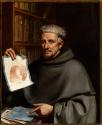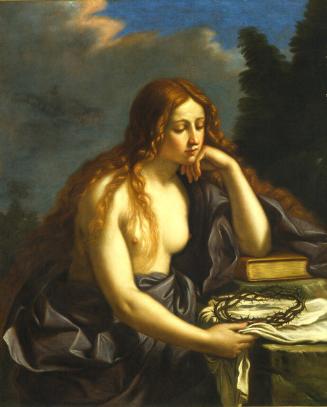Fra Bonaventura Bisi
Artist
GUERCINO (Giovanni Francesco Barbieri)
(Italian, 1591 - 1666)
Depicted
Alfonso IV d'Este
(Italian, 1634 - 1662)
Date1658–1659
CultureItalian
Mediumoil on canvas
ClassificationPaintings
Credit LineMuseum purchase, 2015
Object numberSN11531
Giovanni Francesco Barbieri was the leading Bolognese painter after the death of Guido Reni, and was called Guercino in reference to his pronounced squint. Guercino was born at Cento, near Bologna. He was largely self-taught but influenced by the Carracci and in particular by Ludovico Carracci. In 1621 Guercino was invited to Rome to work for Pope Gregory XV and over the next two years painted a number of influential works that would have great impact on the development of Baroque painting. On the death of the Pope in 1623, Guercino returned to Cento, and then settled in Bologna, probably in 1644, after the death of Guido Reni. In the interveining decade, Guercino’s fame had spread so widely that requests for his paintings came from as far away as England, and he often worked in nearby Bologna and in Modena, where he was summoned in 1632–33 to paint portraits for the young Duke Francesco I d’Este. While Guercino’s earlier pictures typically combine the chiaroscuro effects of Caravaggio with a charm and softness not usually found in followers of this artist, his later work is more academic, closer to the manner of Reni, and lacks the bravura handling and chiaroscuro effects of his earlier paintings.
This extraordinary portrait by Guercino shows Fra Bonaventura Bisi (Bologna, 9 October 1601–5 December 1659 Bologna), a Franciscan friar who resided at the convent of San Francesco in Bologna. Often called “Il Pittorino” or “Padre Pittorino”, Bisi was a well-known engraver and miniature painter. Bisi was also a dealer of paintings and drawings, selling especially to members of the Medici and Este courts at Florence and Modena, respectively. Bisi and Guercino were close friends—Bisi’s surviving correspondence indicates that he sold drawings to Guercino; Guercino made a splendid caricature drawing of the friar, now in the Ashmolean Museum, Oxford (fig. 1); and Guercino is known to have painted two canvases for Bisi, probably as gifts, each depicting a putto with symbols of the Passion. The portrait may likewise have been made as gift from Guercino to Bisi, and indeed, that the picture was made as a personal gesture or token is supported by the fact that the work does not appear in the artist’s account book, the Libro dei conti.
On View
On viewLocation
DimensionsImage: 37 × 30 1/8 in. (94 × 76.5 cm)- Museum of Art, Gallery 11, Wall West
Frame: 48 3/4 × 41 3/4 in. (123.8 × 106 cm)
Guercino (Giovanni Francesco Barbieri)
after 1655
















